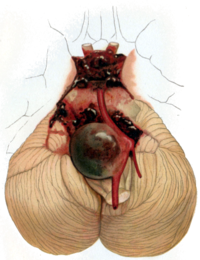
Photo from wikipedia
Abstract Although previous studies have investigated the predictors of posterior communicating artery (PCoA) aneurysm rupture with clinical and radiologic parameters, the accessibility of “small PCoA aneurysms ( Click to show full abstract
Abstract Although previous studies have investigated the predictors of posterior communicating artery (PCoA) aneurysm rupture with clinical and radiologic parameters, the accessibility of “small PCoA aneurysms (<5 mm)” has rarely been reported. Here, we designed a study to identify the factors which are thought to be risky and prone to rupture in small PCoA aneurysms (<5 mm). A total of 114 patients diagnosed with PCoA aneurysm under 5 mm in size on digital subtraction angiography were retrospectively enrolled and divided into ruptured (n = 51) and unruptured (n = 63) groups. Clinical variables were reviewed, and 10 radiologic parameters were obtained, including maximum diameter, height, width, neck width, aspect ratio, dome-to-neck ratio, bleb formation, size ratio, presence of fetal-type PCoA, and inflow angle. Statistical analyses were conducted to compare the groups (ruptured vs unruptured) and identify the risk factors for rupture. High rupture rate of small PCoA aneurysm is noted (51/114, 44.7%). In the comparison analysis, parameters of size ratio (P = .045), aspect ratio (P = .001), and bleb formation (P = .015) were significantly different between the 2 groups. In the regression model, the aspect ratio (P = .045) and bleb formation (P = .004) were significantly associated with the rupture of aneurysm. In respect of small (<5 mm) PCoA aneurysms of our cohort, morphologic parameters of “bleb formation” and “a high aspect ratio” are present more often in ruptured aneurysms as compared to unruptured aneurysms.
Journal Title: Medicine
Year Published: 2022
Link to full text (if available)
Share on Social Media: Sign Up to like & get
recommendations!